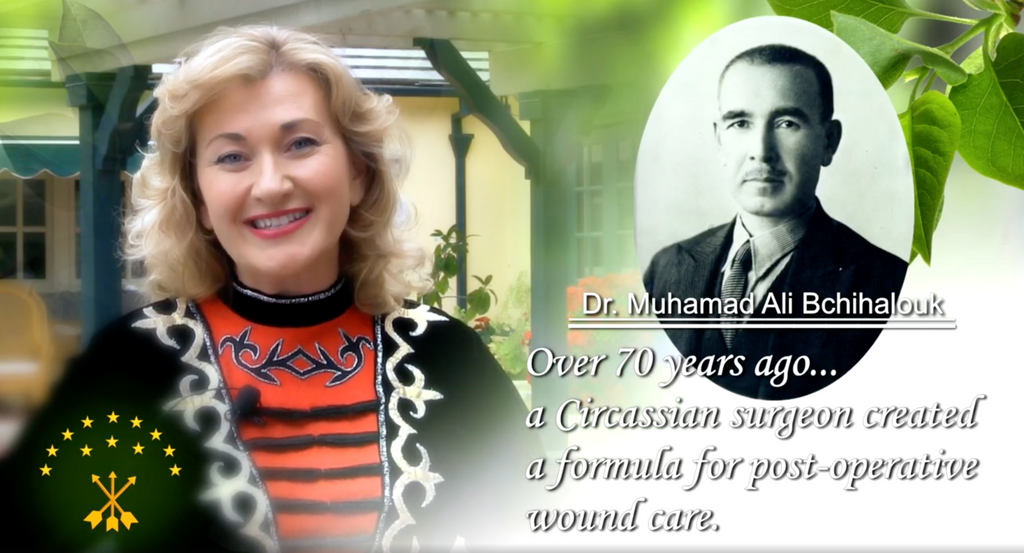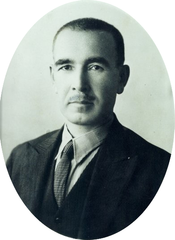The Circassian Surgeon that Created ELAJ

A Leader and Pioneer of the Circassian Culture in the Diaspora
Dr. Muhamad Ali Bchihalouk
This article was written about my grandfather by:
Professor Dr. Adel Abdulsalam (Lash) University of Damascus, Member of the International Adyghe (Circassian) Academy of Science (IAAS)
Damascus 10/15/2015
(Translated from Arabic)
This research revolves around one of the Circassian cultural pioneers in the diaspora, Dr. Muhamad Ali Bchihalouk. He was honored in the symposium conference as a patrons / leaders of the Circassian culture. The symposium was held in Istanbul in 2007. Although I did not attend, I sent this paper and it was read to the audience in the Arabic translation.
Dr. Muhamad Ali Bchihalouk, a pioneer of the Circassian ethnic group in the diaspora in Syria and Turkey. He was well known as a scholar and a philosopher. He was also well versed in Circassian culture in addition to being a medical doctor and a surgeon.


After Russia occupied Circassia in 1864, it forced the Circassians, the original inhabitants of the land, to migrate, leaving their homeland behind seeking refuge in the Ottoman Empire at the Balkan and middle east regions, where some of them, the Bjadough tribe, reached the Golan Heights in Syria with 17,000 refugees of different Circassian tribes. They settled in 14 villages establishing the city Quneitera and settling in different areas in Syria in Damascus.

The Bchihalouk family, of the Bjadough tribe, fled the Caucasus region on a ship heading to Romania then Bulgaria. The family consisted of the father, mother, older brother and his sister Zahra. They moved from the Balkans to Syria where they settled in Damascus, where the father and mother of Muhamad Ali passed away. His sister was married there and his brother became an Imam of a Mosque in Damascus.
The stories are consistent that Muhamad Ali has completed his high school education in Damascus. Then his father sent him to Istanbul to study Medicine, graduating with honor and ranked 65 among the best surgeons in the Ottoman Empire under the reign of Sultan Abdul Hamid the Second (1876-1909).
Unfortunately, I was unable to find the exact date and place of his birth or any accurate information about his childhood and youth days, nor was I able to obtain any detailed information from his children and grandchildren that I met. I recall meeting him in person when I was around the age (17-18). However, all the information that I was able to collect was very little detailed information about our man and insufficient to reflect on his biography, however, I presume that he was born either in 1888 or 1890. But his grandson, Ahmad Jibril heard him state that he was born in 1887 in Circassia or Bulgaria. There is however a consensus that Dr. Bchihalouk worked after finishing medical school as a major with the Ottoman army. He married a Turkish lady (Alaviah Zeinab Hanim), the daughter of (Yusuf Bey Ziya Abdullah Oglu) a prominent and wealthy figure.
After his passing, his daughter and only heiress inherited all his property in Turkey in the area of Adana between Sihan and Jihan rivers in Turkey, in Syria Lebanon and Egypt.
Dr. Bchihalouk was then appointed to Tripoli (Lebanon), after short period, he was transferred to the war front between Iraq and Iran as an Army Doctor residing in Sulaymaniyah during the Ottoman–Safavid war. Muhamad Ali moved there alone since Alaviah Hanim refused to join him, he stayed in Sulaymaniyah for one year, during that time his wife passed away leaving him a great financial wealth he was the only heir to Alaviah Hanim.
In the meantime, he began to suffer more from asthma on his way from Sulaymaniyah to Tripoli. Soon after he settled in Damascus by getting married to (Najiah Hanim), the sister of Sabri Al Asali, of a Circassian mother. Her brother, Sabry Al Asali was the famous Prime Minister of Syria during the era of Syrian independence.
Dr. Bchihalouk was then appointed in Homs, a city north of Damascus, as the chief medical doctor. He later returned back to Damascus developing a reputation as the most brilliant surgeon with rare skills in the region. Soon after, he was appointed as chief medical doctor in Beirut, Lebanon. However, his asthma was aggravated due to the humidity of this coastal city.
There are also stories that Dr. Bchihalouk worked as a biology and anatomy professor at ( Maktab Anbar ) one of the most famous schools in Damascus after the fall of the Ottoman Empire. In 1921, Mohammad Ali traveled with his family to Egypt to look after the farms and real property that he inherited from his first late wife and as a remedial measure treating his asthma in Egypt’s dry weather. To his disappointment and dismay, he found out his brother in law had squandered and embezzled his properties and possessions. Despite the bad situation, Mohammad Ali decided to stay and practice medicine for seven years in Cairo. His clinic was adjacent to the Cairo Fortress and he was known as the (Turkish Doctor). He also worked as a private doctor to a prominent family in Egypt ( possibly, but not confirmed that it was the ruler of Egypt).
Muhamad Ali returned to Damascus with his family in 1928 and settled in the Muhajirin quarter, in a four-bedroom house that was filled with books from wall to wall. He became well known to Circassians in Syria and Syrians alike. He has begotten two sons, Najdat, and my friend Nour al-Salam, and three daughters, Hidayet, Hayat and Najat, who all have since passed away.

Dr. Muhamad Ali and son, Nour Al Salam Bchihalouk
In 1939 he moved from Damascus to the city of Quneitra along with his family except for his son who preferred to stay in Damascus with his uncle Sabri Al Asali. The family resided in a two-story house in the city center dedicating one room to look after his patients with the help of his wife despite her limited medical qualifications. He became one of the most popular doctors in the Golan Heights attracting patients and was known as (Al-Hakim) an Arabic word with a literal meaning of the (Wise man) a local term for a medical doctor. He was a general practitioner treating all illnesses, as commonly practiced by medical doctors of that era, trusting his judgment more than the other three non-Circassians doctors in the Golan region. It was told that he treated his patients truthfully and passionately.
I was also told by one of his Circassian patients that he treated trachoma and other eye illnesses in the region using an ancient Circassian remedy, wiping the eyelid with a black-green glazed stone well known to Circassians, possibly of basalt or Ophiolite green stone before rinsing with astoundingly successful results.
That shows that Dr. Bchihalouk was a general (passé partout) Doctor, who mastered six languages: Circassian, Arabic, Turkish, French, German and English and authored books in both Arabic and Turkish. In the forties of the twentieth century, his illness was aggravated where he became dependent on pain killers preventing him from practicing medicine. His wife Najieh took over the clinic treating patients (without medical qualifications) against the silent objection by medical doctors in the area. Her brother's position and influence protected her from her opponents. Bedouins referred to her as (Al Hakeemah) an Arabic term used in reference to medical doctors.
Due to his medical conditions, he was compelled to leave Quneitera residing in Damascus seeking the proper medical care in specialized hospitals under the care of prominent doctors in the capital, to no avail. Dr. Bchihalouk died in Quneitera and was buried in a cemetery there in 1955. His tombstone carries the Circassian imprint of his extended family and clan.
Dr. Muhamed Ali was proficient in the Circassian language and contributed to the Circassian language in the study of linguistics. He connected the vocabulary creatively and word synonyms as evidence to other languages borrowed from the Circassian language in an effort to prove it was one of the oldest languages on earth. He was also a great chess player, as was a prominent activist in the Circassian national movement in the Golan Heights area. He became the Director of the Circassian school "Adighe Edjap´er" in al-Quneitrah city.
Dr. Bchihalouk was profoundly interested in Circassian history, language, customs, ethnology and everything about his nation. He devoted his knowledge, time and money to study their origin and their connections, and relationships to other old nations and civilizations. He published two books. Ikz al-Muarikhin. (Awakening of the Historians). Printed in (Homs press) in the city of Homs in Syria in 1920. In the Ottoman Turkish language using Arabic alphabets. Aad and Thamood, published in 1939 in the Arabic language with an unknown place of publishing, most likely in Damascus Syria.
Prof. Dr. Adel ABDULSALAM (LASH) Member of the International Adyghe (Circassian) Academy of Science (IAAS)
Damascus 10/15/2015

This article was first published by Dr. Adel Abdulsalam Lash. This research paper was read in a conference in Istanbul in 2015 honoring my late grandfather. This was truly the gift, my family can never repay enough with gratitude to our beloved Scholar, Dr. Adel Abdulsalam... T'hawaGapso (thank you)
Suhein Beck
Granddaughter of Dr. Muhamad Ali Bchihalouk
- Suhein Beck






